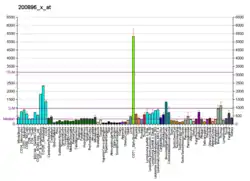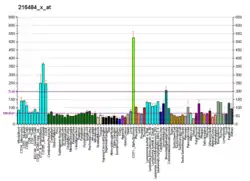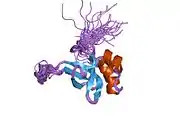Hepatoma-derived growth factor
Hepatoma-derived growth factor (HDGF) also known as high mobility group protein 1-like 2 (HMG-1L2) is a protein that in humans is encoded by the HDGF gene.[5][6]
References
- GRCh38: Ensembl release 89: ENSG00000143321 - Ensembl, May 2017
- GRCm38: Ensembl release 89: ENSMUSG00000004897 - Ensembl, May 2017
- "Human PubMed Reference:". National Center for Biotechnology Information, U.S. National Library of Medicine.
- "Mouse PubMed Reference:". National Center for Biotechnology Information, U.S. National Library of Medicine.
- Wanschura S, Schoenmakers EF, Huysmans C, Bartnitzke S, Van de Ven WJ, Bullerdiek J (May 1997). "Mapping of the gene encoding the human hepatoma-derived growth factor (HDGF) with homology to the high-mobility group (HMG)-1 protein to Xq25". Genomics. 32 (2): 298–300. doi:10.1006/geno.1996.0122. PMID 8833162.
- "Entrez Gene: HDGF hepatoma-derived growth factor (high-mobility group protein 1-like)".
Further reading
- Everett AD, Bushweller J (2003). "Hepatoma derived growth factor is a nuclear targeted mitogen". Current Drug Targets. 4 (5): 367–71. doi:10.2174/1389450033490975. PMID 12816346.
- Nakamura H, Izumoto Y, Kambe H, et al. (1994). "Molecular cloning of complementary DNA for a novel human hepatoma-derived growth factor. Its homology with high mobility group-1 protein". J. Biol. Chem. 269 (40): 25143–9. doi:10.1016/S0021-9258(17)31509-0. PMID 7929202.
- Kishima Y, Yamamoto H, Izumoto Y, et al. (2002). "Hepatoma-derived growth factor stimulates cell growth after translocation to the nucleus by nuclear localization signals". J. Biol. Chem. 277 (12): 10315–22. doi:10.1074/jbc.M111122200. PMID 11751870.
- Strausberg RL, Feingold EA, Grouse LH, et al. (2003). "Generation and initial analysis of more than 15,000 full-length human and mouse cDNA sequences". Proc. Natl. Acad. Sci. U.S.A. 99 (26): 16899–903. Bibcode:2002PNAS...9916899M. doi:10.1073/pnas.242603899. PMC 139241. PMID 12477932.
- Mori M, Morishita H, Nakamura H, et al. (2004). "Hepatoma-derived growth factor is involved in lung remodeling by stimulating epithelial growth". Am. J. Respir. Cell Mol. Biol. 30 (4): 459–69. doi:10.1165/rcmb.2003-0013OC. PMID 12972397.
- Yoshida K, Nakamura H, Okuda Y, et al. (2004). "Expression of hepatoma-derived growth factor in hepatocarcinogenesis". J. Gastroenterol. Hepatol. 18 (11): 1293–301. doi:10.1046/j.1440-1746.2003.03191.x. PMID 14535987. S2CID 24881855.
- Ota T, Suzuki Y, Nishikawa T, et al. (2004). "Complete sequencing and characterization of 21,243 full-length human cDNAs". Nat. Genet. 36 (1): 40–5. doi:10.1038/ng1285. PMID 14702039.
- Shu H, Chen S, Bi Q, et al. (2004). "Identification of phosphoproteins and their phosphorylation sites in the WEHI-231 B lymphoma cell line". Mol. Cell. Proteomics. 3 (3): 279–86. doi:10.1074/mcp.D300003-MCP200. PMID 14729942.
- Everett AD, Narron JV, Stoops T, et al. (2004). "Hepatoma-derived growth factor is a pulmonary endothelial cell-expressed angiogenic factor". Am. J. Physiol. Lung Cell Mol. Physiol. 286 (6): L1194–201. doi:10.1152/ajplung.00427.2003. PMID 14751852. S2CID 17651256.
- Sue SC, Chen JY, Huang TH (2004). "Sequence specific 1H, 13C and 15N resonance assignments of the hath-domain of human hepatoma-derived growth factor". J. Biomol. NMR. 29 (1): 95–6. doi:10.1023/B:JNMR.0000019467.57276.05. PMID 15017145. S2CID 84545598.
- Beausoleil SA, Jedrychowski M, Schwartz D, et al. (2004). "Large-scale characterization of HeLa cell nuclear phosphoproteins". Proc. Natl. Acad. Sci. U.S.A. 101 (33): 12130–5. Bibcode:2004PNAS..10112130B. doi:10.1073/pnas.0404720101. PMC 514446. PMID 15302935.
- Ballif BA, Villén J, Beausoleil SA, et al. (2005). "Phosphoproteomic analysis of the developing mouse brain". Mol. Cell. Proteomics. 3 (11): 1093–101. doi:10.1074/mcp.M400085-MCP200. PMID 15345747.
- Gerhard DS, Wagner L, Feingold EA, et al. (2004). "The status, quality, and expansion of the NIH full-length cDNA project: the Mammalian Gene Collection (MGC)". Genome Res. 14 (10B): 2121–7. doi:10.1101/gr.2596504. PMC 528928. PMID 15489334.
- Shen XY, Zacal N, Singh G, Rainbow AJ (2005). "Alterations in mitochondrial and apoptosis-regulating gene expression in photodynamic therapy-resistant variants of HT29 colon carcinoma cells". Photochem. Photobiol. 81 (2): 306–13. doi:10.1562/2004-07-22-RA-242. PMID 15560738.
- Barrios-Rodiles M, Brown KR, Ozdamar B, et al. (2005). "High-throughput mapping of a dynamic signaling network in mammalian cells". Science. 307 (5715): 1621–5. Bibcode:2005Sci...307.1621B. doi:10.1126/science.1105776. PMID 15761153. S2CID 39457788.
- Iwasaki T, Nakagawa K, Nakamura H, et al. (2005). "Hepatoma-derived growth factor as a prognostic marker in completely resected non-small-cell lung cancer". Oncol. Rep. 13 (6): 1075–80. doi:10.3892/or.13.6.1075. PMID 15870924.
- Gregory SG, Barlow KF, McLay KE, et al. (2006). "The DNA sequence and biological annotation of human chromosome 1". Nature. 441 (7091): 315–21. Bibcode:2006Natur.441..315G. doi:10.1038/nature04727. PMID 16710414.
- Beranova-Giorgianni S, Zhao Y, Desiderio DM, Giorgianni F (2006). "Phosphoproteomic analysis of the human pituitary". Pituitary. 9 (2): 109–20. doi:10.1007/s11102-006-8916-x. PMID 16807684. S2CID 10789246.
- Clermont F, Gonzalez NS, Communi D, Franken S, Dumont JE, Robaye B (2008). "HDGF is dephosphorylated during the early steps of endothelial cell apoptosis in a caspase-dependent way". J Cell Biochem. 104 (4): 1161–1171. doi:10.1002/jcb.21788. PMID 18465786. S2CID 8154321.
External links
- PDBe-KB provides an overview of all the structure information available in the PDB for Human Hepatoma-derived growth factor
This article is issued from Wikipedia. The text is licensed under Creative Commons - Attribution - Sharealike. Additional terms may apply for the media files.







